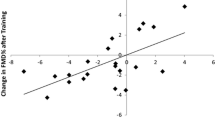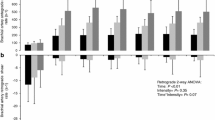Abstract
In older healthy men, aerobic exercise capacity is related to postischemic flow-mediated dilation of the brachial artery (FMD), but corresponding data in a younger population is not available. In addition, whether submaximal aerobic exercise performance also correlates with this kind of vasomotor reactivity is not known. Therefore, in 15 nonsmoking young healthy men [age 27 (5) years; body mass index: 24 (2) kg/m2; mean (SD)] with different levels of ordinary physical activity, but not performing upper-extremity training, we measured FMD at 1 min after reactive hyperemia, and pulmonary oxygen uptake (V̇O2) at ventilatory anaerobic threshold (V̇O2AT) and at peak effort (peak V̇O2) during an incremental exercise on a treadmill. In our participants, FMD was 9.1 (3.4)%, V̇O2AT was 40.72 (5.92) ml/kg per min, and peak V̇O2 was 52.95 (8.13) ml/kg per min. Using bivariate Pearson’s correlation, and in separate multivariate regression analyses, V̇O2AT and peak VO2 showed a significant and reasonably good correlation with FMD (r=0.84, P<0.001 and r=0.77, P=0.001, respectively), independent of age, body mass index and serum total cholesterol (β=0.77, P<0.001, R2 of the overall model=0.79 and β=0.70, P<0.005, R2 of the overall model=0.69, respectively). Our data provide evidence suggesting that in young healthy men a higher submaximal and maximal aerobic exercise performance is associated with a greater FMD of peripheral conduit arteries.

Similar content being viewed by others
References
Beaver WL, Wasserman K, Whipp BJ (1986) A new method for detecting anaerobic threshold by gas exchange. J Appl Physiol 60:2020–2027
Blomqvist CG, Saltin B (1983) Cardiovascular adaptations to physical training. Annu Rev Physiol 45:169–189
Celermajer DS, Sorensen KE, Gooch VM, Spiegelhalter DJ, Miller OI, Sullivan ID, Lloyd JK, Deanfield JE (1992) Non-invasive detection of endothelial dysfunction in children and adults at risk of atherosclerosis. Lancet 340:1111–1115
Celermajer DS, Sorensen KE, Georgakopoulos D, Bull C, Thomas O, Robinson J, Deanfield JE (1993) Cigarette smoking is associated with a dose-dependent and potentially reversible impairment of endothelium-dependent dilation in healthy young adults. Circulation 88:2149–2155
Clarkson P, Celermajer DS, Donald AE, Sampson M, Sorensen KE, Adams M, Yue DK, Betteridge DJ, Deanfield JE (1996) Endothelial dysfunction in insulin dependent diabetes mellitus is related to disease duration and LDL-Cholesterol levels. J Am Coll Cardiol 28:573–579
Clarkson P, Montgomery HE, Mullen MJ, Donald AE, Powe AJ, Bull T, Jubb M, World M, Deanfield JE (1999) Exercise training enhances endothelial function in young men. J Am Coll Cardiol 33:1379–1385
Corretti MC, Plotnick GD, Vogel RA (1995) Technical aspects of evaluating brachial artery vasodilatation using high-frequency ultrasound. Am J Physiol 268:H1397–H1404
Corretti MC, Anderson TJ, Benjamin EJ, Celermajer D, Charbonneau F, Creager MA, Deanfield J, Drexler H, Gerhard-Herman M, Herrington D, Vallance P, Vita J, Vogel R (2002) Guidelines for the ultrasound assessment of endothelial-dependent flow-mediated vasodilation of the brachial artery: a report of the International Brachial Artery Reactivity Task Force. J Am Coll Cardiol 39:257–265
Gaenzer H, Neumayr G, Marschang P, Wolfgang S, Kirchmair R, Patsch JR (2001) Flow-mediated vasodilation of the femoral and brachial artery induced by exercise in healthy nonsmoking and smoking men. J Am Coll Cardiol 38:1313–1319
Gokce N, Keaney JF Jr, Hunter LM, Watkins MT, Nedeljkovic ZS, Menzoian JO, Vita JA (2003) Predictive value of noninvasively determined endothelial dysfunction for long-term cardiovascular events inpatients with peripheral vascular disease. J Am Coll Cardiol 41:1769–1775
Hilton SM (1959) A peripheral arterial conduction mechanism underlying dilation of the femoral artery and concerned in functional vasodilation in the skeletal muscle. J Physiol (Lond) 149:93–111
Hughson RL, Shoemaker JK, Tschakovsky ME, Kowalchuk JM (1996) Dependence of muscle VO2 on blood flow dynamics at onset of forearm exercise. J Appl Physiol 81:1619–1626
Joannides R, Haefeli WE, Linder L, Richard V, Bakkali EH, Thuillez C, Luscher TF (1995) Nitric oxide is responsible for flow-dependent dilatation of human peripheral conduit arteries in vivo. Circulation 91:1314–1319
Kinlay S, Creager MA, Fukumoto M, Hikita H, Fang JC, Selwyn AP, Ganz P (2001) Endothelium-derived nitric oxide regulates arterial elasticity in human arteries in vivo. Hypertension 38:1049–1053
Lie M, Sejersted OM, Kiil F (1970) Local regulation of vascular cross section during change in femoral arterial blood flow in dogs. Circ Res 27:727–737
Laurent S, Lacolley P, Brunel P, Laloux B, Pannier B, Safar M (1990) Flow-dependent vasodilation of brachial artery in essential hypertension. Am J Physiol 258:H1004–H1011
Mannion TC, Vita JA, Keaney JF Jr, Benjamin EJ, Hunter L, Polak JF (1998) Non-invasive assessment of brachial artery endothelial vasomotor function: the effect of cuff position on level of discomfort and vasomotor responses. Vasc Med 3:263–267
Meredith IT, Currie KE, Anderson TJ, Roddy MA, Ganz P, Creager MA (1996) Postischemic vasodilatation in human forearm is dependent on endothelium-derived nitric oxide. Am J Physiol 270:H1435–H1440
Nichols WW, O’Rourke MF (1998) Properties of the arterial wall: practice. In: Nichols WW, O’Rourke MF (eds) McDonald’s blood flow in arteries: theoretical, experimental and clinical principles, 4th edn. Arnold, London, pp 73–97
O’Rourke M (1990) Arterial stiffness, systolic blood pressure, and logical treatment of arterial hypertension. Hypertension 15:339–347
Rådegrand G (1997) Ultrasound estimates of femoral artery blood flow during dynamic knee extensor exercise in humans. J Appl Physiol 83:1383–1388
Rådegrand G, Saltin B (2000) Human femoral artery diameter in relation to knee extensor muscle mass, peak blood flow, and oxygen uptake. Am J Physiol 278:H162–H167
Ramsey MW, Jones CJH (1994) Large arteries are more than passive conduits. Br Heart J 72:3–4
Rinder MR, Spina RJ, Ehsani AA (2000) Enhanced endothelium-dependent vasodilation in older endurance-trained men. J Appl Physiol 88:761–766
Rywik TM, Blackman MR, Yataco AR, Vaitkevicius PV, Zink RC, Cottrell EH, Wright JG, Katzel LI, Fleg JL (1999) Enhanced endothelial vasoreactivity in endurance-trained older men. J Appl Physiol 87:2136–2142
Segal SS, Jacobs TL (2001) Role for endothelial cell conduction in ascending vasodialtion and exercise hyperemia in hamster skeletal muscle. J Physiol (Lond) 536:937–946
Shoemaker JK, MacDonald MJ, Hughson RL (1997) Time course of brachial artery diameter responses to rhythmic handgrip exercise in humans. Cardiovasc Res 35:125–131
Sinoway LI, Hendrickson C, Davidson WR, Prophet S, Zelis R (1989) Characteristics of flow-mediated brachial artery vasodilation in human subjects. Circ Res 64:32–42
Sorensen KE, Celermajer DS, Georgakopoulous D, Hatcher G, Betteridge DJ, Deanfiled JE (1994) Impairment of endothelium-dependent dilation is an early event in children with familial hypercholesterolemia and is related to the lipoprotein(a) level. J Clin Invest 93:50–55
Sorensen KE, Celermajer DS, Spiegelhalter DJ, Georgakopoulos D, Robinson J, Thomas O, Deanfield JE (1995) Non-invasive measurement of human endothelium dependent arterial responses: accuracy and reproducibility. Br Heart J 74:247–253
Vogel RA, Corretti MC, Plotnick GD (2000) A comparison of brachial artery flow-mediated vasodilation using upper and lower arm arterial occlusion in subjects with and without coronary risk factors. Clin Cardiol 23:571–575
Wagner PD (1996) Determinants of maximal oxygen transport and utilization. Annu Rev Physiol 58:21–50
Wasserman K, Hansen JE, Sue DY, Casaburi R, Whipp BJ (1999) Principles of exercise testing and interpretation including pathophysiology and clinical applications, 3rd edn. Lippincott Williams & Wilkins, Baltimore, Md., pp 77–78
Acknowledgements
Dr E. A. Palmieri was supported in part by a grant from the Consorzio Interuniversitario per la Ricerca Cardiovascolare (2003).
Author information
Authors and Affiliations
Corresponding author
Rights and permissions
About this article
Cite this article
Palmieri, E.A., Palmieri, V., Innelli, P. et al. Aerobic exercise performance correlates with post-ischemic flow-mediated dilation of the brachial artery in young healthy men. Eur J Appl Physiol 94, 113–117 (2005). https://doi.org/10.1007/s00421-004-1285-0
Accepted:
Published:
Issue Date:
DOI: https://doi.org/10.1007/s00421-004-1285-0




